
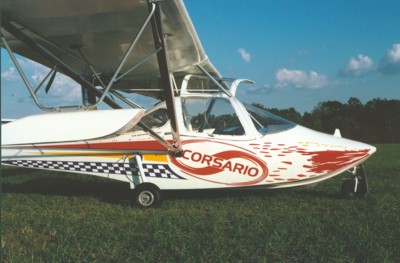
COLORFUL – When it sits in the water you don’t see any of these colors, a shame, as this Corsario is quite eye-catching when it poses on wheels.

LEVER QUADRANT – Between the occupants are a series of levers controlling throttle (dual knobs), trim, and brakes. The gear retract lever is forward of all these.
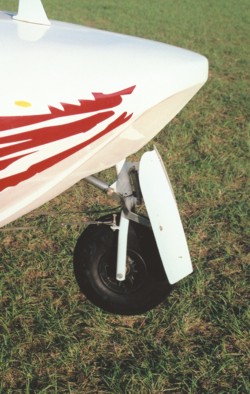
SWINGER – The nosewheel folds back, as does the main gear, only this nosewheel buries itself in the forward fuselage while the mains stay in plain sight.
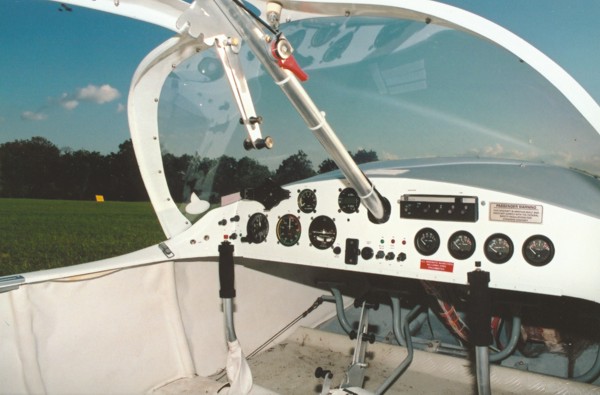
BRIGHT CABIN – With its white interior, the Corsario is light and airy plus its 44-inch width assures room even for two larger occupants. Note the flaps lever mounted on the cabin roof.
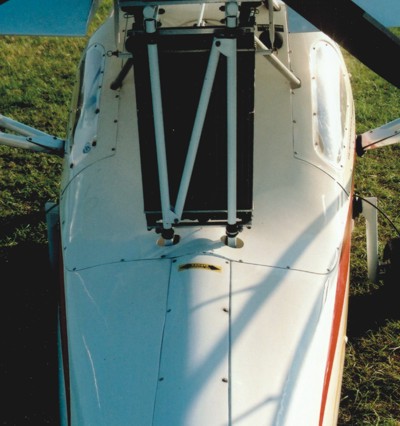
WELL PROTECTED – Microleve hides the 100-hp Rotax 912S radiator securely behind the cabin and above the broad hull, but it sees plenty of airflow in this position.

BOAT HULL – Some floatplane lovers swear by the boathull design, and Brazilian manufacturer Microleve preserves the hull shape even on the door covering the nosewheel.
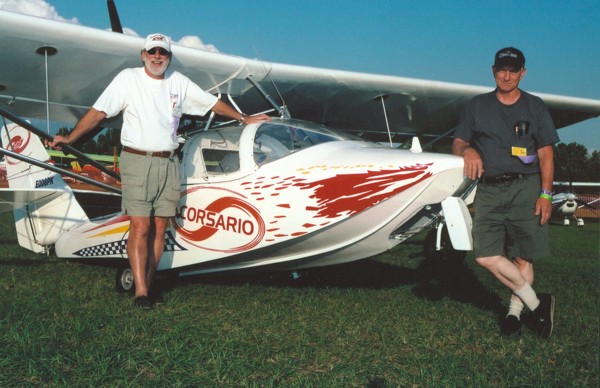
MAIN MEN – Steve Cohen (left), the importer of the Corsario, flanks the amphibian with his airshow pilot, Mike Makepeace.
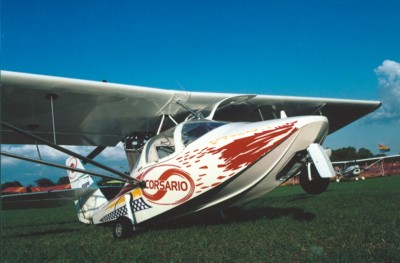
FULLY RETRACTABLE – The Corsario has retractable, er, repositionable landing gear that either hides behind a door or swings up behind the struts.

DUAL CONTROLS – Besides dual joystick, the Corsario has rudder pedals in each position, allowing the aircraft to be useful for training or aircraft checkouts.
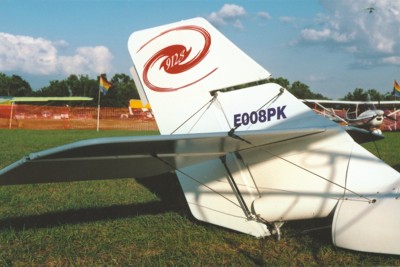
AMPLY BRACED – With double wire bracing on the tail, this structure is very sturdy even for the pounding rough water can deliver to the tail.

BIG POWER – Using the 100-hp Rotax 912S, the Corsario leaps off the water quickly, even when we executed a downwind takeoff (see article).
Brazilian Amphibious Beauty
Most Americans
are unaware of the Corsario. Importer Steven Cohen is out to change that. He and his partner, Phil Klein, are marketing this handsome amphibian, which they import from Brazil. Not a brand-new design, this is the MK5 model – it’s been through four previous iterations.
The Corsario comes from a South American company called Microleve founded in 1982, back near the beginning of the ultralight era. The company proudly states, “Aside from being the first ultralight manufacturer in Brazil, the quality of our products has made Microleve the biggest seller of ultralight aircraft in Latin America.”
In 23 years of operation, Microleve claims to have delivered more than 1,400 ultralight aircraft, including almost 20 different models, named as MX1, MX2, ML200, ML300, ML300M, ML300MF, ML400, ML400T, ML450, ML500T, CORSARIO MK1, MK2, MK3, MK4, and MK5. As you might surmise by reviewing this list, the Brazilian company has taken several of their models through a series of refinements and the Corsario is no exception.
In addition to sales through Cohen’s Sport Air Aviation enterprise here in America, Microleve has exported to numerous countries including Japan, Italy, France, Korea, Portugal, Greece, Angola, Paraguay, Argentina, and Peru. Microleve says their longevity allows them to maintain an inventory of spare parts for all models.
The company’s slogan is, “Microleve, flying side-by-side with you!” That’s a comforting thought for Yankees considering the purchase of an airplane from a seemingly faraway land.
Why Corsario?
Cohen and Klein can tick off a number of reasons why they think the Corsario is a great amphibious aircraft to consider buying: exceptional visibility, great flotation for short water takeoffs, good flight performance, a comfortable and quiet cabin, side-by-side seating with easy entry and exit through gull-wing doors, a large instrument panel, flaps, retractable tricycle gear, reasonable fuel consumption and low operating costs (compared to general aviation seaplanes), plus ease of flight. One thing this long list leaves out is a modest price tag - at least for an amphibian.
My experience with the Corsario came on a fairly windy day that produced considerable chop on the water of Florida’s Lake Parker. Floatplane flying is more pleasant on calmer days, but this proved the Corsario could handle other conditions. I flew with light aircraft veteran, Mike Makepeace, with whom I’ve shared the cockpit in at least two other airplanes.
I was impressed that the airplane seemed sturdy and tight, though the turbulent day gave ample challenge. Makepeace and I felt the Corsario seemed more affected by turbulence than its weight would seem to suggest. To me this airplane felt on the heavy side - indeed, Sport Air Aviation reported empty weight at 685 pounds with the big Rotax 912S engine – and this impression was amplified by the noise of the choppy water beating against the hull.
We took on water after I tried to water taxi too quickly before my first takeoff; doing so forced more water through a leaky seal, which I’ll talk about later.
This Corsario obviously has been giving pleasure to its owner, Phil Klein, as it had enough time on it that the shine of a new production plane was dulled in places of wear. Even allowing for normal wear-and-tear I didn’t find the finish work up to standard with top-of-the-line sport aircraft.
Nonetheless, Microleve deserves recognition for their laudable effort to hide the Corsario’s inner workings. Instead of exposed components as often seen in light aircraft, Microleve covers control linkages and all the central controls are nicely covered with fiberglass covers. Not only do these enhance the interior’s look, they protect control linkages from occupants entering the cabin. Since all the Corsario’s interior components are white, the cabin has a bright look that lightens the interior.
Balancing my comments about finish, Makepeace – who has built several airplanes – believed the construction quality of the components was quite good.
Further countering my negatives over the Corsario’s weighty feel and the hull’s loud reaction to choppy water is the fact that this is an amphibious aircraft. Water-and land-versatility comes at the expense of some hardware weight and the Corsario seems built quite sturdily.
Well-Equipped
The Corsario has more systems to manage than many recreational aircraft. Some of these systems have to do with gear retraction; however, I didn’t get to sample that part of the aircraft.
Though Makepeace flew daily at Sun ‘n Fun, he had not flown this aircraft before seeing it in Florida. He told me he did about 40 water landings to get familiar with it. Combined with his existing talent, Makepeace easily learned the machine. However, following these training flights, he and Klein attempted to beach the Corsario at the boat ramp at Lake Parker. A steep and rough ramp, most ultralight seaplanes I’ve seen struggle in the attempt to use it. You really have to gun the engine and
then get on the brakes once you reach the top. It can be done, but on your first try you tend not to hit it perfectly. The ramp was made for boat trailers, not airplane landing gear. So when Makepeace and Klein folded the nosewheel under trying, I couldn’t be too critical of the machine.
Klein said the problem started with the nosewheel door cover that extends down in front of the nosewheel, and is only a few inches off the ground. He figures the door cover caught the rough ramp at Lake Parker and pressed itself against the wheel, acting like a brake. Therefore, the nosewheel couldn’t turn and when the big engine pushed harder, the nosewheel linkage yielded. The high thrust line also tends to rotate the plane onto its nose.
Unfortunately, this damage left me unable to work the gear; I didn’t want the gear legs to stick in the wrong location since we flew only from water. Fortunately, the damage wasn’t significant; Makepeace and Klein were able to remedy the situation so Makepeace could land on turf back at Sun ‘n Fun.
However, in this incident, a seal had been compromised around the nosewheel such that we took on water rapidly. We had taxied out across the lake as the wind blew unusually from the east, an offshore breeze. In a few minutes of attempted fast taxiing, we were pumping water through the nosewheel seal breach. We were concerned we’d taken on too much water for takeoff so we taxied back to shore. Klein helped as we put the nose on land and let the bilge pump empty the fuselage bottom. This proved the bilge pump is up to the job as it quickly drained the water. When we took off again, we used the powerful Rotax 912S and its 100 horsepower to get off the water quickly, even in a tailwind. By mistake, perhaps, I had learned more about the airplane than I normally would have.
Due to those earlier challenges with the nosewheel, we were unable to cycle the gear. Neither Makepeace nor I were positive it would function correctly, so we didn’t tempt fate. I didn’t want to risk a full flight regime, so I didn’t insist on retracting and extending. The gear-retract mechanism is controlled through a lever forward of the quadrant that houses the throttle, trim, and dual
brake levers. The gear-retract lever has a slide lever to release the overcenter catch. This lever looked rather short for the amount of work it has to do, but since I didn’t retract or extend gear, I can’t comment on how easy or hard this may be to do.
Wide, Low Rider
Boathull amphibians are a lot different than amphibious float-equipped airplanes. One of the most notable differences is how low you sit in the water. Contrarily, float-equipped landplanes always sit well above the water.
The Corsario also sits low in the water; the entire bottomside is under the water line. I didn’t even see the plane’s bright paint job until it was back on land at Sun ‘n Fun. In level position at rest, your shoulder is only inches above the water line.
Entering the Corsario proved easy enough for three reasons: One, the plane’s low posture means you step down into it. Two, the doors open gull-wing style, making a large opening through which to pass. Three, the Corsario’s interior is finished in such a way that entry – more specifically where feet and hands are put – poses less of a problem than in planes where linkages and wires can be kicked as you enter.
A 1/4-inch-diameter flexible spring holds open the Corsario’s windows. When in column (straight), the spring holds the window open quite well as long as you don’t bump it. When you want to close the window, simply pull on the spring anywhere in the column and the spring bends. The door closure’s forward latch was rather difficult to manipulate but, once connected, was quite secure.
Seating comfort was good. The seats are simple fiberglass shells covered with fabric and padding. Inside you have a 44-inch-wide cockpit that’s bigger than the interior of a Cessna 172.
An impressive number of switches dotted the instrument panel formed from a drop-down flange aft of the front deck. Klein’s Corsario had several conventional engine and flight instruments, a transponder, and a tiny Microair 760-channel radio the size of a standard round instrument. All of the switches were labeled in tiny type that I found a bit challenging to read quickly. One of these switches controlled a fan for heating, a control that surprised me given this airplane’s Florida home.
Boating Around
Earlier I wrote about a leaky seal around the nosewheel that had been damaged. This also included a small crack in the boathull that Klein found later. The result of these openings meant that when we taxied out for takeoff, we took on unwanted water. However, our first aborted takeoff meant I had extra time to assess the Corsario’s water handling.
The Corsario does not use any water rudders. All water maneuvering is via prop blast to the tail, but this proved to be adequately effective even in some wind. For those unaware of seaplane taxiing, going downwind is always a challenge. If you don’t keep blast on the tail, an airplane naturally weather vanes. The Corsario was quite easily controlled while taxiing downwind, albeit with plenty of prop blast. Since the wind was offshore, our beachings were simple but a good-flying seaplane always handles well into the wind.
After the bilge pump quickly evacuated most of the water we’d collected in our out-and-back taxi, we were ready to do the downwind launch.
When using the Corsario’s throttle, you must remember that the engine location and center of thrust are quite high relative to the airplane’s center of mass. Any sharp application of the throttle on the water pushed the nose over quite distinctively. The water offers lots of resistance to forward motion and combined with 100 horsepower, the pitching motion is exacerbated.
The trim lever is located directly adjacent to the throttle. Makepeace was able to use the trim and throttle similarly to the way you use dual throttles on a twin-engine aircraft. He worked the trim actively to offset the power changes. For example, as he pushed forward on the throttle (which would rotate the nose downward), he would pull aft on the trim to offset the throttle action. Since the trim was a very effective aerodynamic device, it didn’t take a lot of movement to bring noticeable response. Trim appears well designed because it is not overly responsive. However, all this trim movement came with a price, though not while I was aboard.
Flaps are positioned between the occupants on a simple lever after the forward support tube structure. Three notches plus zero proved easy to apply and helped bring us in on a steeper approach path.
When landing in some choppy water, the Corsario’s boat hull felt the chop much more so than Lotus floats just flown on the M-Squared Sprint. Of course, most seaplane flyers prefer calm water, but very smooth water has its own challenges – namely, that still water resembles a mirror and makes it hard to judge your distance off the surface.
I felt the Corsario had some tendency to porpoise; it seemed the step was further aft than optimal, though I’m no hydroengineer. Once you get up on step, if your technique needs additional training like mine did, the porpoising tendency is more obvious. Makepeace had to help me understand how to control this. You should plan to take a little training before flying the Corsario, I believe. It isn’t a hard airplane to fly but the right techniques are valuable, especially regarding higher-speed water operations. This is no condemnation; most floatplanes require some finesse.
The good news of that 100-hp Rotax is that you aren’t in the water very long, as our downwind takeoff convincingly proved. Once the Corsario leaves the water, it seems to leave a few pounds behind.
Bird Out of Water
Practice will make perfect in Corsario takeoffs and landings. But once she leaves the water, the plane wants to fly.
The Corsario rolled quite respectably. I estimate the rate at 3.5 to 4.0 seconds in a 45°-to-45° evaluation. Though response was good, handling was not perfectly harmonized. I found the ailerons were a bit more responsive than the rudder. I suspect the rudder has somewhat less volume than optimal.
I didn’t fly the plane with the gear down because of the recent nosewheel malfunction. But Makepeace indicated he found the nose hunts rather consistently with the gear down. That large nosewheel and its gear door may act like a reverse rudder, he suggested. A solution is simple: retract it.
Makepeace agreed that the Corsario seems not to have as much rudder authority as he prefers. However, this aircraft was not fitted with gap seals over the tail plane’s fixed and moving parts. In a simple resolution, Makepeace added some tape over those seals and reports improving the authority. Klein confirmed that the Brazilian manufacturer will be applying this technique at the factory in the future.
The Corsario exhibited a good climb rate. Makepeace observed that right off the turf runway he was seeing more than 1,000 fpm. I didn’t see such performance off the water, but we had extra water weight and I’m heavier than Makepeace and he recorded his climb rate while solo. With the two of us and some water weight, I think we were still below gross but climb was 700-800 fpm. This is acceptable with a Rotax 912S, but shows the plane has some weight in its structure.
Makepeace said with the gear hanging down, as would be the case for a normal hard-surface landing, the aircraft’s performance and handling were somewhat affected. The nosewheel and door come into the equation, as do the big main wheels. The theme to be learned here is that getting the gear up will help the Corsario just as it does a general aviation airplane with retractable gear.
The Corsario carries 22 gallons of fuel, enough to run pretty hard for better than 4 hours, longer with gear up and throttle retarded. Microleve says the Corsario’s glide is 10:1, a respectable number for a seaplane. The structure is stressed for +4 -2 Gs.
Focus on the Trim Tab
When I evaluated the Corsario for adverse yaw, Makepeace thought I’d believe it was significant. Compared to all other airplanes I’ve flown, I felt it was better than average. Adverse yaw was, however, more pronounced to the left than to the right. I believe this is fully attributable to P-factor.
The plane also exhibited a good stall routine with a falling nose, but nothing far out of the ordinary. Yet after our flight ended – which went well except for water coming onboard – something a little more serious occurred. I didn’t hear of it until after Makepeace and I met up at Sun ‘n Fun to continue our discussions.
Makepeace informed me that he experienced elevator flutter. In all my years of flying airplanes for review articles, I’ve only experienced flutter once and it was also at the elevator. It was darn scary, and I feel sure Makepeace’s experience with the Corsario also captivated his attention. The trim tab’s movement, an investigation showed, initiated the observed flutter.
Microleve uses a Teleflex cable to adjust the trim tab. This cable emerges from the fuselage in the vertical stabilizer, according to Klein. At that point, the Teleflex connects to a bracket that translates pilot input motions to the trim tab. The problem is, the Teleflex meets a too-short bracket in such a way that a bending load (of close to 30°) is placed on the steel Teleflex fitting right where it is threaded. After repeated use – Makepeace did lots of takeoffs and landings and adjusted the trim regularly (see article) – the Teleflex fitting failed. This left the trim to freely float. Since it moves opposite the elevator normally, it set up a fluttering motion that Makepeace could not control. As with my own experience he got off on the power and eased back on the stick. When the power is removed and some forward speed is lessened, the flutter stopped as quickly as it started. After carefully examining the airplane, Makepeace and Klein removed the freely moving trim tab and Makepeace was able to fly the Corsario back to Sun ‘n Fun without incident.
Klein subsequently installed a longer bracket so that the Teleflex fitting now reaches the bracket at a neutral angle. This should permanently fix the problem. And as Microleve personnel were present, they saw the problem and can now examine other Corsarios. Microleve says the problem had not appeared earlier.
Corsario MK5 and
LSA Plans
Base price for a fully built Corsario complete with the 81-hp Rotax 912 engine is $34,950. An Aventura II with Rotax 912 can be several thousand less but comes as a kit. Sport Air Aviation sells the Corsario MK5 with standard 81-hp Rotax 912 and a 3-blade Warp Drive propeller with nickel-coated leading edge for $36,950. A Corsario MK5 with the 100-hp Hirth 3701 and the same Warp Drive prop sells for $33,950.
If your budget is larger, you can add value with these options: 100-hp Rotax 912S engine upgrade ($2,000); Stits wing covering ($3,000); Microair 760 VHF radio ($950); Microair T2000 transponder ($1,600); and a BRS ballistic recovery parachute for which you’ll have to call to get the price.
Klein also reports that Microleve is quite responsive about deliveries. He indicates that an order today would typically take about 3 months, two of which are waiting for a ship to bring the goods north. “Eduardo Clark can also supply parts in two weeks, so American customers don’t have to worry,” says Klein.
Engines are purchased and installed in the USA to save Microleve from buying the Austrian engine and shipping it all around the planet. Also, instruments are added and wiring is done in the USA.
While Sport Air Aviation’s price seems most reasonable for a fully built Rotax 912-powered aircraft, two problems stand in the way at present: One, Sport Air Aviation plans to bring the Corsario in as a light sport aircraft (LSA), but the company doesn’t have an S-LSA airworthiness certificate at this time. Two, the FAA is still pondering the “repositionable” landing gear issue currently facing amphibious seaplanes. According to recent comments from highly placed FAA officials, they still believe they will solve the problem but the end isn’t in sight.
Both the above reasons are why Progressive Aerodyne must sell its Sea Rey as a kit, just as Aero Adventures does with its Aventura II. Since the Corsario is not presently available as a kit or as a S-LSA, you can only operate under the Experimental Exhibition Category. That may be enough for you, typically meaning you can’t travel further than 25 miles from a base of operations. But for many, that isn’t a good solution and you generally cannot change an Exhibition category airplane to Light-Sport Aircraft.
Interested pilots should call to check the status of Light-Sport Aircraft certification. But when Microleve can make their Statement of Compliance and gain approval from FAA or a Designated Airworthiness Representative (DAR), the Corsario may gain quite a customer list. You probably ought to call or write now.
| Seating | 2, side-by-side |
| Empty weight | 685 pounds |
| Gross weight | 1,232 pounds |
| Wingspan | 33 feet |
| Wing area | 160 square feet |
| Wing loading | 7.7 pounds/square foot |
| Length | 22 feet, 6 inches |
| Height | 7 feet |
| Kit type | Assembly |
| Build time | 80 hours 1 |
| Notes: | 1 Assembly effort includes installing engine, prop, wiring, and plumbing; fuselage is fully assembled, seats covered, wings fully assembled and painted with Stits process. |
| Standard engine | Rotax 912 |
| Power | 81 hp |
| Power loading | 12.3 pounds per hp |
| Cruise speed | 55-85 mph |
| Never exceed speed | 100 mph |
| Rate of climb at gross | 700 fpm |
| Takeoff distance at gross | 215 feet |
| Landing distance at gross | 390 feet |
| Standard Features | (as sold in the USA) 81-hp Rotax 912, electric starter, 3-blade prop, ASI, altimeter, water temperature, tachometer, fully enclosed cabin with gull-wing doors and 44-inch-wide seating area, in-flight trim, remote choke, repositionable landing gear, steerable nosewheel, brakes, dope-and-fabric wings and tail. |
| Options | 100-hp Rotax 912S, radio, transponder, flight and engine instruments, ballistic parachute. |
| Construction | Aluminum airframe with steel components, fiberglass boat hull, dope-and-fabric wing coverings. Made in Brazil; distributed by U.S.-owned company. |
Design
Cosmetic appearance, structural integrity, achievement of design goals, effectiveness of aerodynamics, ergonomics.
Pros – New U.S. entry for a 5th-generation design from Brazil. The Corsario’s boat hull makes a cleaner seaplane than float add-on configurations. Fiberglass hull with aluminum airframe and dope-and-fabric wings (common to U.S. ultralight construction).
Cons – Unknown design to American pilots (though operating in other countries for years). Rotax 912-powered Corsario is still fairly new for manufacturer; a few minor changes have been made recently. Rather heavy for its class.
Systems
Subsystems available to pilot such as: Flaps; Fuel sources; Electric start; In-air restart; Brakes; Engine controls; Navigations; Radio; (items covered may be optional).
Pros – Plenty of levers and knobs for those who enjoy systems. Flaps, gear-retract (with over center release), trim, differential brakes, bilge pump, cockpit choke, plus a good selection of radio and instrument controls. Trim was particularly effective, useful when water taxiing (see article).
Cons – Lots of systems come with a requirement to learn them all; I never got to retract or extend the gear. This well-equipped amphibian weighs like it’s feature-laden (at well over 600 pounds, the Corsario is bulked up).
Cockpit/Cabin
Instrumentation; Ergonomics of controls; Creature comforts; (items covered may be optional).
Pros – Dual gull-wing doors make for easy entry, especially when combined with a low-profile aircraft in the water (you step down into the cockpit). Though I didn’t use them on water, the brakes are differential. Cockpit has interior panels to protect and complete. Flaps were accessible and easy to check visually. Wide, roomy cabin.
Cons – The Corsario’s finish is not as slick as high-end LSAs (though it has only half their price tag). No seat adjustments. Panel was a bit distant to reach easily, certainly so for switches installed on the opposite side. Fuel tanks are right behind you in the cabin (but they’re easily checked for quantity).
Ground Handling
Taxi visibility; Steering; Turn radius; Shock absorption; Stance/Stability; Braking.
Pros – With a Rotax 912S blast over a close tail, the Corsario handled well on the water, even in a moderate downwind, slow-speed taxi test. Good visibility for water traffic, even somewhat aft. Differential brakes weren’t tested but appeared well-positioned to aid tight-quarter maneuvering.
Cons – Even with good tail response, water rudders can be helpful for tighter maneuvering at slow speeds, like near docks. The Corsario felt the rough chop of the water much more than Lotus floats flown immediately afterward. You sit very low in the water.
Takeoff/Landing
Qualities; Efficiency; Ease; Comparative values.
Pros – Excellent forward and lateral visibility during all takeoff or landing operations. Approach speeds were modest, 55 mph (given a heavier airframe). Flaps easily operated and helped control approach path well; secure detent positions allow movement by feel.
Cons – The Corsario shows more tendency to porpoise, requiring the right response from the pilot; some familiarization training will be helpful. Did not get to experience land takeoff/landings; Makepeace says lowered gear cuts performance.
Control
Quality and quantity for: Coordination; Authority; Pressures; Response; and Coupling.
Pros – Good aileron response; approximately 3.5 seconds, 45° -to -45°. Adverse yaw seemed low to me (though Makepeace believed I’d feel otherwise). Precision turns to headings went well, even in moderately strong winds; crosswinds should present no great challenges.
Cons – Harmony wasn’t perfect; the rudder lacked the authority that the ailerons had, demanding more rudder to get a balanced response. Makepeace saw improvement after tail plane gaps were closed with tape; builder plans to include gap closures. Dutch rolls required plenty of rudder.
Performance
Climb; Glide; Sink; Cruise/stall/max speeds; Endurance; Range; Maneuverability.
Pros – The Rotax 912 engine demonstrated it could an push the Corsario off the water quickly (see article). Makepeace reports climb above 1,000 fpm when he flew solo off land. Factory states a 10:1 glide, reasonably flat for an amphibian. Cruise performance at 85 mph is quite strong for a seaplane.
Cons – Climb seems less enthusiastic than anticipated with 100-hp Rotax engine, at about 700 fpm near gross. Cruise at 85 mph is no longer thought particularly fast (at least for an airplane of this weight). Faster speeds on water require some familiarity with the Corsario controls.
Stability
Stall recovery and characteristics; Dampening; Spiral stability; Adverse yaw qualities.
Pros – Low adverse yaw. Stalls were mild even though the nose broke over. Handling was predictable throughout the envelope. Trim can partially offset water taxiing nose-over tendency when adding power to the high-thrust position; Makepeace worked both controls with one hand quite effectively.
Cons – Nose fall-through speed wasn’t a problem but the wing clearly wants more airflow after stall (due, I think, to the higher empty weight). Makepeace indicated the nose tended to hunt when the nose gear was extended. See article for description of trim linkage malfunction.
Overall
Addresses the questions: “Will a buyer get what he/she expects to buy, and did the designer/builder achieve the chosen goal?”
Pros – Priced with comparable designs, except those designs are kits where the Corsario plans to qualify as a LSA; mid- to high-$30,000s represents a good value for an amphibian boathull design. Well-equipped even at basic prices. Experienced international importer running U.S. distribution. Importer reports good parts support and no long delivery delays (see article).
Cons – Until Corsario issues a Statement of Compliance for LSA, sales of fully built aircraft present challenges; Experimental Exhibition is about all that’s available. Overall finish is more ultralight basic than fancy LSA. Water operations can be tough on airplanes; how well will Corsario hold up?


Leave a Reply